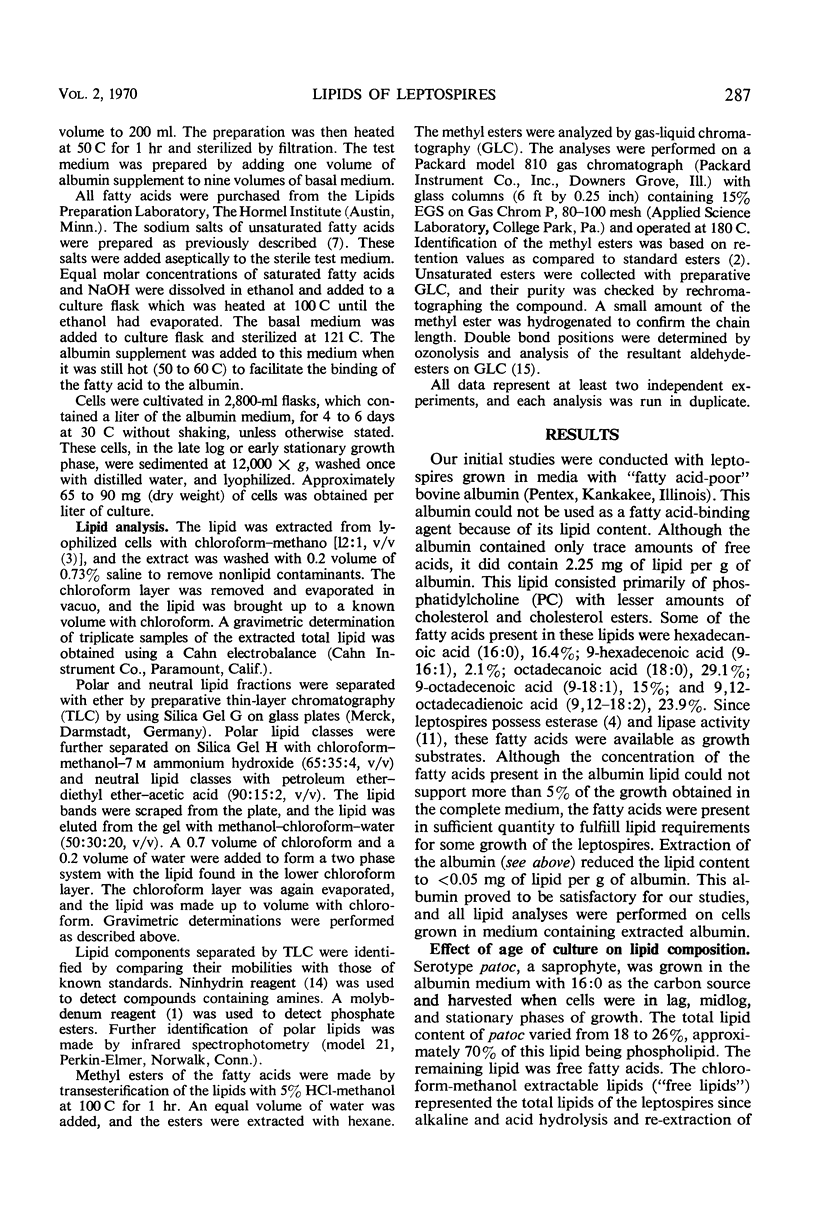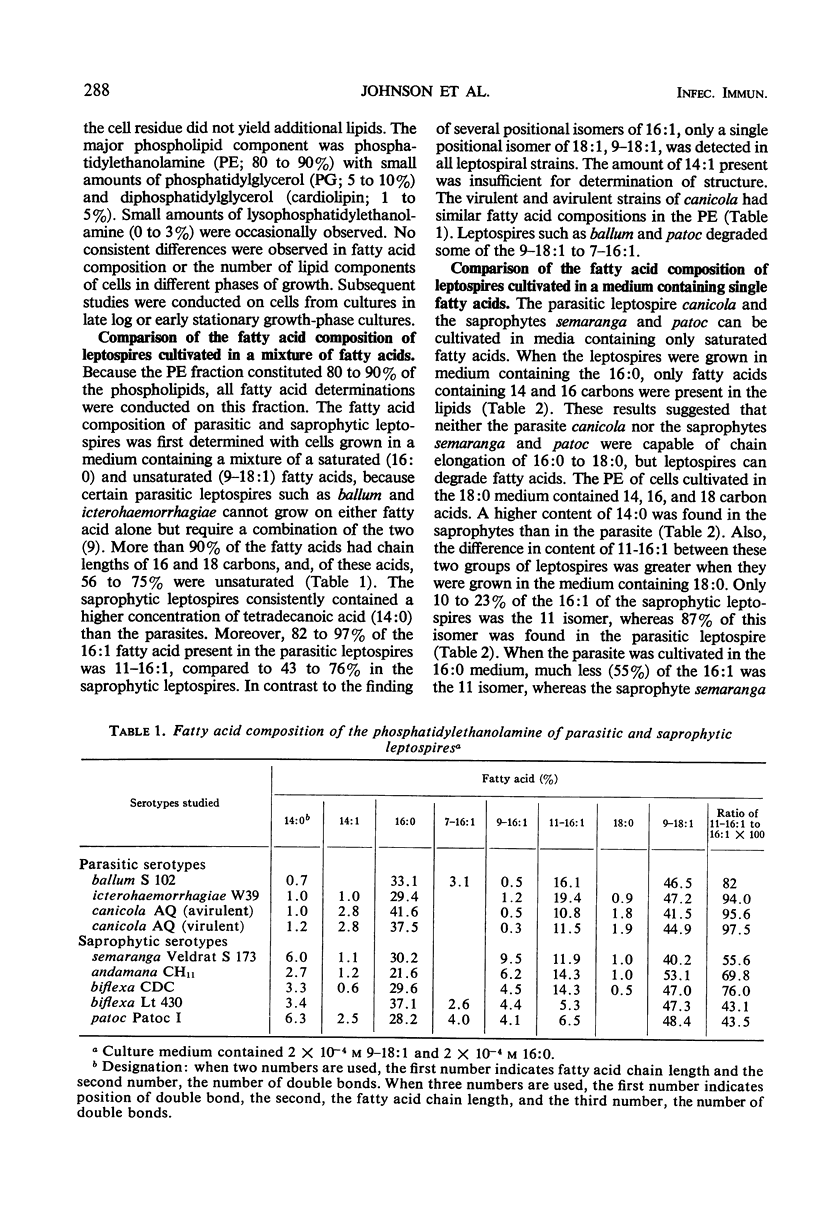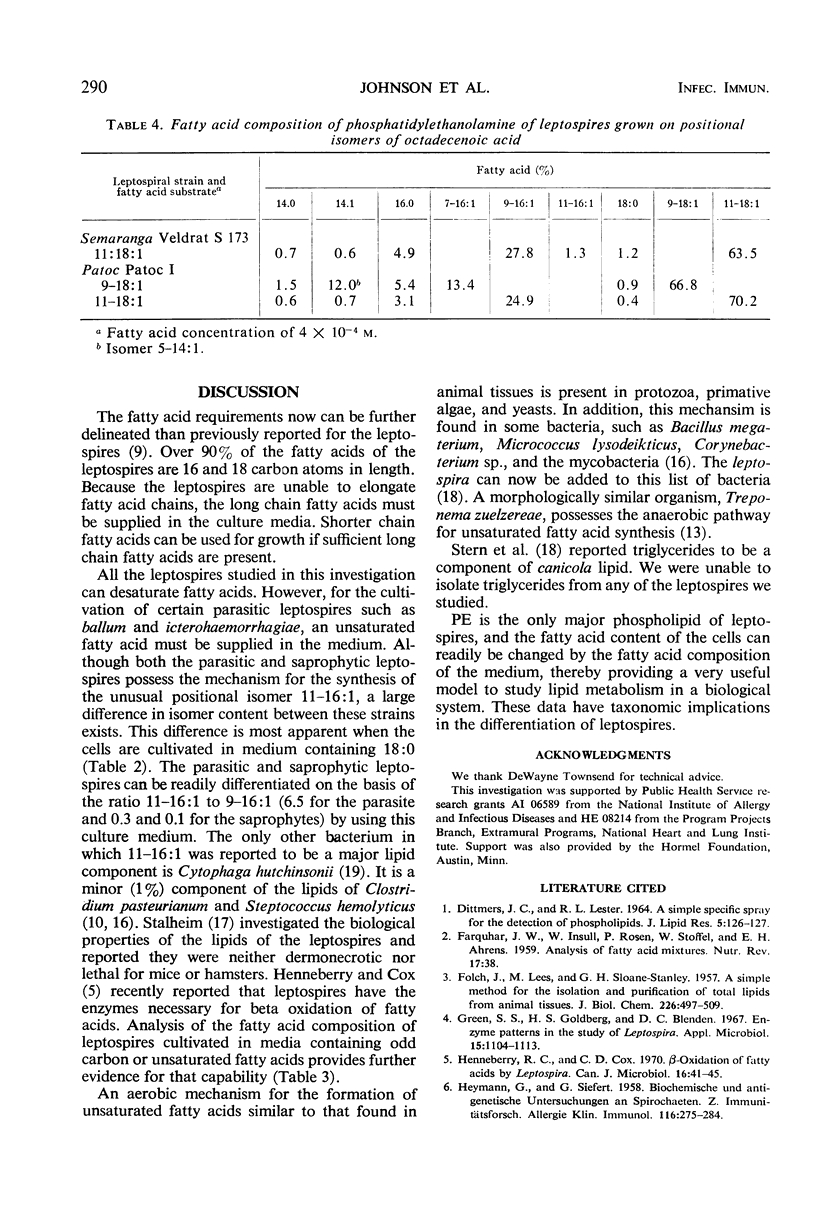Abstract
The lipid composition of five parasitic and six saprophytic leptospires was compared. Lipids comprise 18 to 26% of the dry weight of the cells after chloroform-methanol extraction. No residual (bound) lipid was found after acid or alkaline hydrolysis of the extracted residue. The total lipid was composed of 60 to 70% phospholipid, and the remaining lipid was free fatty acids. The phospholipid fraction contained phosphatidylethanolamine as the major component, and phosphatidylglycerol and diphosphatidylglycerol were minor components with traces of lysophatidylethanolamine sometimes found. The major fatty acids of leptospires were hexadecanoic, hexadecenoic, and octadecenoic acids. Both the unusual cis-11-hexadecenoic acid and the more common cis-9-hexadecenoic acid were synthesized by the leptospires. Neither the parasitic nor the saprophytic leptospires can chain elongate fatty acids. However, they were capable of β-oxidation of fatty acids. Both groups of leptospires desaturate fatty acids by an aerobic pathway. When the parasite canicola was cultivated on octadecanoic acid, 87% of the hexadecenoic acid was the 11 isomer, whereas the saprophyte semeranga consisted of 10% of this isomer. In addition, the saprophytic leptospires contained more tetradecanoic acid than the parasites. No differences were observed in the lipid composition of virulent and avirulent strains of canicola.
Full text
PDF





Selected References
These references are in PubMed. This may not be the complete list of references from this article.
- DITTMER J. C., LESTER R. L. A SIMPLE, SPECIFIC SPRAY FOR THE DETECTION OF PHOSPHOLIPIDS ON THIN-LAYER CHROMATOGRAMS. J Lipid Res. 1964 Jan;5:126–127. [PubMed] [Google Scholar]
- FOLCH J., LEES M., SLOANE STANLEY G. H. A simple method for the isolation and purification of total lipides from animal tissues. J Biol Chem. 1957 May;226(1):497–509. [PubMed] [Google Scholar]
- Green S. S., Goldberg H. S., Blenden D. C. Enzyme patterns in the study of leptospira. Appl Microbiol. 1967 Sep;15(5):1104–1113. doi: 10.1128/am.15.5.1104-1113.1967. [DOI] [PMC free article] [PubMed] [Google Scholar]
- HEYMANN G., SIEFERT G. Experimentelle Untersuchungen über Spirochaeten-Antigene. I. Biochemische Analyse der Struktur-Elemente verschiedener Spirochaeten. Z Immun exp ther. 1958 Sep;116(3):257–275. [PubMed] [Google Scholar]
- Henneberry R. C., Cox C. D. Beta-oxidation of fatty acids by Leptospira. Can J Microbiol. 1970 Jan;16(1):41–45. doi: 10.1139/m70-007. [DOI] [PubMed] [Google Scholar]
- Jenkin H. M., Anderson L. E., Holman R. T., Ismail I. A., Gunstone F. D. Effect of isomeric cis-octadecenoic acids on the growth of Leptospira interrogans serotype patoc. J Bacteriol. 1969 Jun;98(3):1026–1029. doi: 10.1128/jb.98.3.1026-1029.1969. [DOI] [PMC free article] [PubMed] [Google Scholar]
- Johnson R. C., Harris V. G. Differentiation of pathogenic and saprophytic letospires. I. Growth at low temperatures. J Bacteriol. 1967 Jul;94(1):27–31. doi: 10.1128/jb.94.1.27-31.1967. [DOI] [PMC free article] [PubMed] [Google Scholar]
- Johnson R. C., Harris V. G., Walby J. K. Characterization of leptospires according to fatty acid requirements. J Gen Microbiol. 1969 Mar;55(3):399–407. doi: 10.1099/00221287-55-3-399. [DOI] [PubMed] [Google Scholar]
- Kates M. Bacterial lipids. Adv Lipid Res. 1964;2:17–90. [PubMed] [Google Scholar]
- Livermore B. P., Johnson R. C., Jenkin H. M. Isolation of an unusual positional isomer of hexadecenoic acid from a parasitic leptospire. Lipids. 1969 Mar;4(2):166–167. doi: 10.1007/BF02531939. [DOI] [PubMed] [Google Scholar]
- Meyer H., Meyer F. Biosynthesis of unsaturated fatty acids by a free-living spirochete. Biochim Biophys Acta. 1969 Jan 21;176(1):202–204. doi: 10.1016/0005-2760(69)90091-5. [DOI] [PubMed] [Google Scholar]
- SAND D., SEN N., SCHLENK H. POSITIONAL ISOMERISM OF UNSATURATED FATTY ACIDS IN THE RAT. QUANTIFICATION OF ISOMERIC MIXTURES. J Am Oil Chem Soc. 1965 Jun;42:511–516. doi: 10.1007/BF02540093. [DOI] [PubMed] [Google Scholar]
- SCHEURBRANDT G., BLOCH K. Unsaturated fatty acids in microorganisms. J Biol Chem. 1962 Jul;237:2064–2068. [PubMed] [Google Scholar]
- Stalheim O. H. Biological effects of leptospiral lipids. J Bacteriol. 1968 Feb;95(2):465–468. doi: 10.1128/jb.95.2.465-468.1968. [DOI] [PMC free article] [PubMed] [Google Scholar]
- Stern N., Shenberg E., Tietz A. Studies on the metabolism of fatty acids in Leptospira: the biosynthesis of delta 9- and delta 11-monounsaturated acids. Eur J Biochem. 1969 Mar;8(1):101–108. doi: 10.1111/j.1432-1033.1969.tb00501.x. [DOI] [PubMed] [Google Scholar]
- THE GENESIS and absorption of intestinal ammonia. Nutr Rev. 1959 Feb;17(2):38–40. doi: 10.1111/j.1753-4887.1959.tb06378.x. [DOI] [PubMed] [Google Scholar]
- Walker R. W. Cis-11-hexadecenoic acid from Cytophaga hutchinsonii lipids. Lipids. 1969 Jan;4(1):15–18. doi: 10.1007/BF02531788. [DOI] [PubMed] [Google Scholar]


